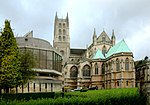Stratton-on-the-Fosse

Stratton-on-the-Fosse is a village and civil parish located on the edge of the Mendip Hills, 2 miles (3 km) south-west of Westfield, 6 miles (10 km) north-east of Shepton Mallet, and 9 miles (14 km) from Frome, in Somerset, England. It has a population of 1,108, and has a rural agricultural landscape, although it was part of the once-thriving Somerset coalfield. Within the boundaries of the parish are the hamlets of Benter and Nettlebridge. Stratton-on-the-Fosse straddles the Fosse Way, an ancient Roman road which linked the cities of Lincoln and Exeter. It lies between the parish of Westfield, Somerset and the village of Oakhill. St Vigor and St John Church of England Primary School is situated in nearby Chilcompton.
Excerpt from the Wikipedia article Stratton-on-the-Fosse (License: CC BY-SA 3.0, Authors, Images).Stratton-on-the-Fosse
Green Lane, Mendip Stratton on the Fosse
Geographical coordinates (GPS) Address Nearby Places Show on map
Geographical coordinates (GPS)
| Latitude | Longitude |
|---|---|
| N 51.25262 ° | E -2.49573 ° |
Address
Downside School
Green Lane
BA3 4RJ Mendip, Stratton on the Fosse
England, United Kingdom
Open on Google Maps








